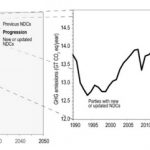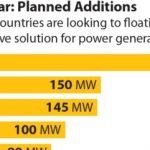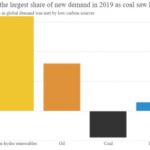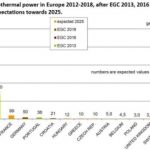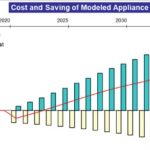UCO (Used Cooking Oil) is a feedstock for biofuels. In 2023, European countries consumed close to seven million tonnes of UCO for biofuels. This is four times the continent’s maximum potential for supplying it domestically, so the rest comes from imports, mostly from China, Malaysia and Indonesia. The vast majority is blended for biodiesel to use in cars and trucks. UCO accounted for one third of conventional biodiesel feedstocks and a quarter of … [Read more...]
China’s Belt and Road Initiative is now building more Renewables, less Coal
Energy has always made up the majority of investments and construction deals signed through China’s Belt and Road Initiative (BRI). Until very recently these investments were dominated by fossil fuel projects. But in the first half of this year, over 40% of BRI energy projects announced were wind and solar, with 22% each for gas and oil, and zero for coal projects. The reasons include China’s stated commitment to clean energy, avoiding the risk … [Read more...]
Annual Energy Efficiency improvements must double to meet climate targets. We know how to do it
Global energy intensity – a measure of how efficiently the global economy uses energy – improved by just over 2% in 2022. That needs to double to 4% annually to 2030 to meet global efficiency targets, explains Brian Motherway at the IEA. If achieved, by 2030 one unit of energy used will generate 40% more economic output than today. That’s huge, and shows why few other policy areas offer such widespread benefits. More than half of the 150 … [Read more...]
Resource nationalism is not the United States’ biggest minerals problem
A growing number of resource-rich nations are planning to restrict exports of unprocessed raw materials, explain Gracelin Baskaran and Cy McGeady at CSIS. Currently, a significant proportion of critical minerals are exported to China for processing, giving it monopoly power in the value chain. If countries like the DRC, Namibia, Ghana, Zimbabwe, and Indonesia instead processed their own raw materials they would create skilled jobs and industries … [Read more...]
Carbon Pricing: almost 25% of emissions now covered globally, but coverage and prices must rise further
Despite early scepticism, carbon pricing is making its mark globally. Today almost a quarter of global greenhouse gas (GHG) emissions are covered by a carbon price, compared to just 7% ten years ago. 73 national and sub-national jurisdictions have carbon pricing, explain Joseph Pryor and Venkat Ramana Putti at The World Bank, writing for the Florence School of Regulation and quoting from the World Bank’s State and Trends of Carbon Pricing 2023 … [Read more...]
CO2 emissions from Land Use: country-level data for turning “emitters” into “sinks”
Until carbon capture technologies take off (if at all!), the world’s CO2 removals depend entirely on nature. Clemens Schwingshackl, Wolfgang Obermeier and Julia Pongratz at Ludwig Maximilian University of Munich, writing for Carbon Brief, review the latest data on “carbon fluxes” which measure whether the land is a net “source” of carbon or a “sink.” Flux measurements are categorised: deforestation, forestation, wood-harvest emissions, removals … [Read more...]
Biofuel is approaching a feedstock crunch. How bad? And what must be done?
The IEA is warning that biodiesel, renewable diesel and biojet fuel producers are heading for a feedstock supply crunch over the next five years. Rising prices are the signal to seek out new supplies and solutions, which should – and are - driving the development of government programmes and industry innovation. Here, the IEA lays out their projections for 2022-2027, covering all the main feedstocks: sugars, maize, soy oil, rapeseed oil, palm … [Read more...]
COP26: a strategy for tackling “imported deforestation”
Palm oil, beef, cocoa, coffee, soy, and other agricultural products are responsible for deforestation in the producing countries. Of the 10m hectares of tropical forest lost each year, two-thirds can be unambiguously attributed to agricultural expansion and international trade is responsible for about half of this. The EC is due in December to unveil a legislative proposal to address the issue. Alain Karsenty and Nicolas Picard, writing for IFRI, … [Read more...]
PET: a toolkit to make existing Coal plants more efficient
Many nations are struggling to phase out coal. Some, like China, are heavily dependent on it, and have more plants in the pipeline to ensure energy security and keep prices low. In other words, a lot of coal will remain in operation for the medium term. Given that, it makes sense to make them more efficient while they are in use. Daisy Chi at ECECP looks at a new set of tools – the Plant Efficiency Toolbox (PET) - that can analyse and optimise a … [Read more...]
Updated NDCs: World committing to 0.5% emissions cuts by 2030. It should be 45%
The latest national climate pledges, submitted over the new year, show that the world is nowhere near meeting our emissions reductions goals. Analysis of the 48 updated “nationally determined contributions” (NDCs) submitted so far (everyone must submit by the end of this year), covering nations responsible for 29% of global emissions, shows we will have 0.5% lower emissions in 2030 compared to 2010. That’s way off the target 45% reduction needed. … [Read more...]
Floating Solar: can it help ASEAN reverse coal’s continued rise?
Floating solar farms may be gaining traction in Asia. Capacity is still small: by 2019 the big players Japan and China had a combined floating photovoltaic (FPV) installed capacity of 1.3GW. But the ASEAN countries that had virtually nothing before 2019 now have over 51MW and have planned in another 858MW. A report by Sara Jane Ahmed and Elrika Hamdi at IEEFA explains why FPV is looking better and cheaper at balancing out peaks and troughs than … [Read more...]
BP’s world energy review: 2019 saw clean electricity match coal
Simon Evans at Carbon Brief summarises BP’s 69th edition of its influential annual statistical review of world energy, looking at 2019. Overall, total energy demand rose, though slower than usual. Renewables were the largest source of new energy, but were closely followed by oil and gas. Coal use dropped again, the fourth drop in six years, thanks to historic declines in the EU and the US. But continued growth in SE Asia, China and India leaves … [Read more...]
German Geothermal: from 1.2TWh to 100TWh by 2050?
The IEA’s Sustainable Development Scenario sees the world's geothermal power generation tripling to almost 300 TWh by 2030. That’s because there’s an almost unlimited supply that can provide power, heating and cooling. It’s also a continuous supply uninterrupted by the weather, unlike solar and wind. The plants are small and quiet. For heating, ground-source heat pumps use significantly less electricity than other technologies. Writing for CLEW, … [Read more...]
Developing nations: Efficiency is cheaper than Coal in Indonesia
Developing economies face a particularly big challenge in reducing emissions. Their economies are growing rapidly, industrialising and urbanising. Their populations surely deserve the same rewards of wealth that the rich countries – the historical and per capita big emitters - have experienced. Can they get there without all the emissions? Indonesia believes so, committing itself to 29% unconditional emissions reductions by 2030. Virginie … [Read more...]











